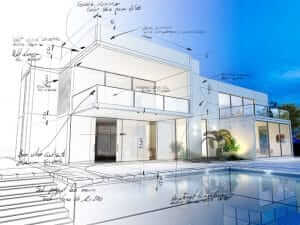
When designing a home as either the owner or an architect, flaws can happen. Some are more common than others. Driving down the road, you may not notice them, but living day to day with many can become tiresome.
This post will list out seven of the most common architecture design flaws we’ve found in homes.
- Not Enough Natural Light: Homes (particularly in America) have gotten bigger and bigger. More space means more to light, but many designs just leave darker houses. Making larger rooms means having them located in directions close to the most natural light.
- Not Enough Lighting: Like natural light, many large homes are not sufficiently lit via electricity either. High ceilings make the lighting less effective and is commonly missed in the design process. This leads to floor lamps that may not fit with the original scheme.
- Improper Sizing of Windows: Perhaps the most common flaw that leads to poor natural light is having windows that are too small. Larger homes can accommodate bigger windows, but stock windows are used. This creates dark spaces in the home, regardless of how well the home is situated in relation to the sun.
- Too Much Storage Space: Larger homes typically have some 4-6 family members. These homes have large walk-in closets and other storage spaces that lead to much of the areas being unused. One of the main design ideas from Frank Lloyd Wright was not building all kinds of storage spaces in a home, i.e. closets, garages, etc. to avoid clutter. Frank Lloyd Wright hated clutter and it shows in some of his more famous houses.
- Awkward Spaces: Bonus rooms, weird walls, and other awkward spaces may seem wanted at first. However, once the family gets settled, they may wonder why the house is built in such a way. They may think things like, “The bonus room isn’t really big enough for anything cool” or “That one bathroom is never used”.
- Bad Materials: Mass neighborhood builds are notorious for using sub-par materials or what contractors call “builder grade” materials. Thinner drywall, cheap doors, and chintzy butt hinges are a few culprits. Investing in quality materials is always the best option to create homes that last. Bump up the budget to things like better insulation or SOSS Invisible Hinges.
- Potentially Dated Designs: About 20 years ago, big pillars on the front porch were all the rage. Now…not so much. That said, a nice wrap around porch has always been admired. Choosing the designs in and out of a home will determine how well received the home will be for the long haul.
If you are an individual who wants to build your own house or an architect that designs entire neighborhoods full of new homes—these mistakes can affect you. Avoiding them can mean lifelong enjoyment of your home or the satisfaction of knowing that your designs will be cherished by those who dwell inside them.